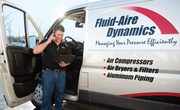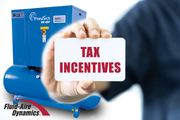Compressed air is the “fourth utility” for manufacturers — and by far the most expensive. However, studies have shown that up to 35% of compressed air is wasted in industrial facilities on average. Increasing the efficiency of your compressed air system could reduce energy costs by 30% or more, saving thousands in energy expenses every year. Here are the top seven to reduce compressed air system costs.

On average, 35% of energy costs associated with compressed air can be considered wasted energy.
1. Eliminate Air Leaks
Compressed air leaks may start small, but they can quickly add up to a big problem. Leaks in your compressed air system sap the compressor’s output and can increase the energy costs for compressed air systems by 30% or more.
How much does a compressed air leak cost? A 1-CFM leak costs about $35/shift annually per shift — and compressed air systems may have hundreds of leaks. That can add up to thousands of dollars each year.

Based on an average cost of $35 per leak per shift. Large compressed air systems may have more than 100 leaks if they have not been maintained regularly.
To reduce lost air volume and energy costs, find and fix leaks in your system. You may be able to find some yourself, by simply listening for the tell-tale hiss at the leak site. Hoses, fittings and connectors are common culprits for air loss. But to find smaller leaks, you will likely need to call in a professional for a compressed air system audit. During the audit, the technician will use an ultrasonic leak detector (or ultrasonic acoustic detector) to pinpoint leaks too small to detect using human senses. Once the leaks are identified, they can be addressed by tightening connections, replacing faulty fittings, or patching or replacing damaged sections of piping. This is one of the fastest ways to reduce compressed air costs.
Leaks can develop at any time, so this is not a one-time fix. Your system should be inspected for leaks on a regular basis. Fortunately, you may be able to fix compressed air leaks for free through energy incentives offered by your power company. Contact us if you’d like to find out more.
2. Check Plant Pressure

Your second big opportunity to save energy in compressed air systems is maintaining an appropriate pressure level for the pneumatic processes in the plant. Many plants are operating at a higher air pressure (PSI) than they need to run tools and equipment. There is no benefit to operating at higher pressures than required for efficient equipment operation. Reducing plant pressure could save hundreds or thousands on your energy bill each year.
On average, a 2 PSI reduction in overall plant pressure saves 1% in energy costs for the entire compressed air system. And many plants are operating at pressures 15 to 20 PSI above what they really need. Lowering plant pressure by just 10 PSI could reduce compressed air energy bills by 5% or more.
Why are manufacturing facilities operating at higher PSIs than necessary? Excessive pressure drop is one of the big culprits. This may be due to leaks in the compressed air distribution system (see above), undersized compressed air piping, clogged inline filters or other blockages in the system. To compensate for pressure drop at the end of the lines, manufacturers may simply raise the PSI for the whole system so that tools at the end of distribution runs operate correctly. However, fixing the cause of pressure drop and lowering PSI is almost always more cost-effective in the long run.
3. Eliminate Wasteful Air Uses
Leaks aren’t the only cause of compressed air waste in many facilities. Wasteful uses of compressed air can add hundreds of dollars to your annual energy bills and put extra strain on your air compressor. Some of the most common culprits are:
- Clean-up/blow-off
- Drying or process cooling
- Sparging
- Personal cooling
In each of these cases, compressed air is a relatively expensive way to solve the problem at hand. It may be more convenient (or fun) to blow sawdust off a workstation than to pick up a brush or a broom, but it is not the best use of compressed air or the most effective way to clean. And applications like drying, cooling or sparging don’t require compressed air. Regular fans or low-pressure blowers are better suited for these processes. Before using compressed air for an application, ask whether pressurized air is truly required and if there are better (and cheaper) ways to achieve the goal.
Idle equipment can be another source of compressed air waste. Small leaks in valves or couplers supplying air to the equipment can result in air loss even when equipment is not running. Disconnect unused equipment from your compressed air system and turn off the air valves for equipment that is sitting idle for extended periods of time.
Reducing compressed air waste may require some retraining for employees. Small changes in behaviors and processes can help you optimize compressed air usage and save energy.
4. Stay on Top of Maintenance

Maintenance is essential for an industrial compressed air system. Regular preventative maintenance will improve the energy efficiency of your system and reduce energy expenses.
Dirty or clogged compressed air filters, in particular, can be an energy drain in compressed air systems. As filters become loaded with particulate, it takes more energy to move air through them. This becomes evident as pressure drop across the filter. When you don’t change your filters often enough, your air compressor has to work harder.
Compressed air inline filters should be changed at least once a year or after 4,000 hours of operation. If the intake air is very dirty, or you are experiencing high oil carryover from your compressor, they may need to be changed more often. Also check and change the air intake filter on a regular basis.
In addition to performing all standard PM activities for the air compressors, make sure the area around the compressor is clean and allows for adequate airflow to prevent compressor overheating. Keeping the area around the compressor clean will reduce the particulate that ends up in your filters, extending filter life. Also, inspect your distribution system to make sure there are no blockages from corrosion or other contaminants. A clean, well-maintained compressed air system will run at maximum efficiency and lower compressed air costs.
5. Consider a VSD Air Compressor
If your compressed air usage varies over the course of a shift, day or season, you may benefit from a variable speed drive (VSD) air compressor. A VSD compressor ramps the speed of the motor up or down in response to real-time demand. That means when demand is lower, the motor is running at a reduced speed, which saves energy. This is in contrast to a fixed-speed air compressor, which is always operating at maximum capacity, even when air demand is low. In some circumstances, a VSD compressor can slash energy consumption by up to 70%!
Intec Group LLC saved $18,000 in energy costs by upgrading to a VSD air compressor and VSD dryer from PneuTech. Read the case study to learn more.
A VSD compressor provides maximum savings for facilities with variable compressed air use. Fully robotic facilities using compressed air at the same rate 24/7/365 may not see as much benefit from switching to a VSD compressor. However, for facilities with intermittent air use across the day or big swings in demand from season to season, a VSD can take a big bite out of energy bills.

Best of all, your energy company may cover some or all of the cost of switching to a VSD compressor. Energy incentives offered by many power companies will offset the cost of upgrading.
6. Proper System Design and Sizing
Proper compressed air system design is one of the most critical steps in reducing compressed air energy costs. That includes not just the compressor but the entire compressed air system. A well-designed compressed air system not only meets your production demands but also maximizes energy efficiency, ultimately lowering your operational expenses. Fluid-Aire Dynamics offers expert compressed air system design services to optimize your system for energy efficiency and reliability.
See how we helped SCM Group maximize energy efficiency with a three-compressor system.
Common energy-sapping mistakes include:
-
Improper compressor sizing: Oversizing a compressor leads to wasted energy, as the unit runs inefficiently and consumes more power than needed. Undersizing, on the other hand, forces the compressor to work overtime, increasing equipment wear and tear, energy use and operational costs due to constant cycling. A CFM calculator can help with proper system sizing.
-
Poor distribution system design: Incorrectly sized or routed piping creates pressure drops, forcing compressors to work harder and consume more energy to maintain adequate pressure, significantly increasing energy bills.
-
Inadequate compressed air storage capacity: Without sufficient air storage, compressors must cycle on more frequently to meet peak demand requirements, which increases compressed air costs and wear on the equipment. Proper storage also reduces pressure fluctuations and energy usage.
-
Improper placement of dryers or filters: Placing dryers and filters too far from the point of use causes pressure losses, forcing the compressor to compensate by working harder, resulting in higher energy costs.
-
Inefficient condensate drains: A manual drain or timer drain releases a bit of the air supply each time it is opened. Zero-loss drains only open when needed, reducing air loss.
7. Conduct a Comprehensive System Audit
A compressed air system audit or energy study is key to uncovering inefficiencies and maximizing energy savings. Compressed air system auditors look at various aspects of system performance to identify pressure drops, leaks, improper sizing, and other issues that drive up energy costs. A simple amperage data logging study can also uncover many hidden inefficiencies that might otherwise go unnoticed can be uncovered. For example, these studies shed light on average compressor duty cycle, time spent loaded vs. unloaded, variability in compressed air demand over a shift or week, and the total energy costs associated with producing compressed air. These insights can be used to optimize the system and reduce energy use.
Fluid-Aire Dynamics has extensive experience in performing data logging studies and compressed air system audits, helping businesses optimize performance, reduce costs, and extend the life of their equipment.
Start Reducing Energy Costs for Your Entire Compressed Air System!
By following these steps — including fixing leaks, reducing pressure, eliminating wasteful uses of air, performing all required maintenance, and optimizing your system based on performance data — you can significantly lower your energy bills and improve the efficiency and service life of your compressed air system. These simple yet effective steps help you reduce waste, extend equipment life, and save money in the long run.
Need help implementing these strategies? Let Fluid-Aire Dynamics help you cut your compressed air energy costs. Contact us for a free consultation.




